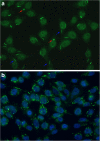Clinical associations and potential novel antigenic targets of autoantibodies directed against rods and rings in chronic hepatitis C infection
- PMID: 23506439
- PMCID: PMC3606316
- DOI: 10.1186/1471-230X-13-50
Clinical associations and potential novel antigenic targets of autoantibodies directed against rods and rings in chronic hepatitis C infection
Abstract
Background: Chronic hepatitis C virus (HCV) infection is frequently associated with extrahepatic autoimmune disorders while interferon (IFN) and ribavirin treatment may exacerbate these conditions. Autoantibodies from HCV patients identify a novel indirect immunofluorescence (IIF) pattern on HEp-2 cells characterized by cytoplasmic rods and rings (RR). Our objectives were to determine the prevalence and clinical associations of RR autoantibodies in HCV patients, and identify related novel autoantibody targets.
Methods: Sera from 315 patients with HCV (301 treatment naive, 14 treated with interferon and/or ribavirin) were analyzed for the presence of RR antibodies by IIF on commercially available HEp-2 cell substrates. Antibodies to inosine monophosphate dehydrogenase 2 (IMPDH2) and cytidine triphosphate synthase 1 (CTPS1) were detected by addressable laser bead assay and other potential targets were identified by immunoscreening a protein microarray. Clinical and demographic data including HCV genotype, mode of infection, prior antiviral therapy, and histological findings were compared between RR antibody positive (RR+) and negative (RR-) patients.
Results: The median age of the HCV cohort was 51 years, 61% were male, and 76% were infected with HCV genotype 1 (G1). Four percent (n=14) had been treated with IFN-based therapy (IFN monotherapy, n=3; IFN/ribavirin, n=11); all had a sustained virologic response. In total, 15 patients (5% of the cohort) were RR+. RR+ and RR- patients had similar demographic and clinical characteristics including age, sex, mode of HCV infection, prevalence of the G1 HCV genotype, and moderate to severe fibrosis. Nevertheless, RR+ patients were significantly more likely than RR- cases to have been treated with IFN-based therapy (33% vs. 3%; adjusted odds ratio 20.5 [95% confidence interval 5.1-83.2]; P<0.0005). Only 1/10 RR positive sera had detectable antibodies to IMPHD2 and none had antibodies to CTPS1. Potentially important autoantibody targets identified on protein arrays included Myc-associated zinc finger protein (MAZI) and ankyrin repeat motif.
Conclusion: The majority of HCV patients with RR autoantibodies previously received IFN/ribavirin antiviral therapy. Further studies are necessary to determine the genesis of intracellular RR and elucidate the clinically relevant autoantigens as well as the clinical and prognostic significance of their cognate autoantibodies.
Figures

References
Publication types
MeSH terms
Substances
Grants and funding
LinkOut - more resources
Full Text Sources
Other Literature Sources

